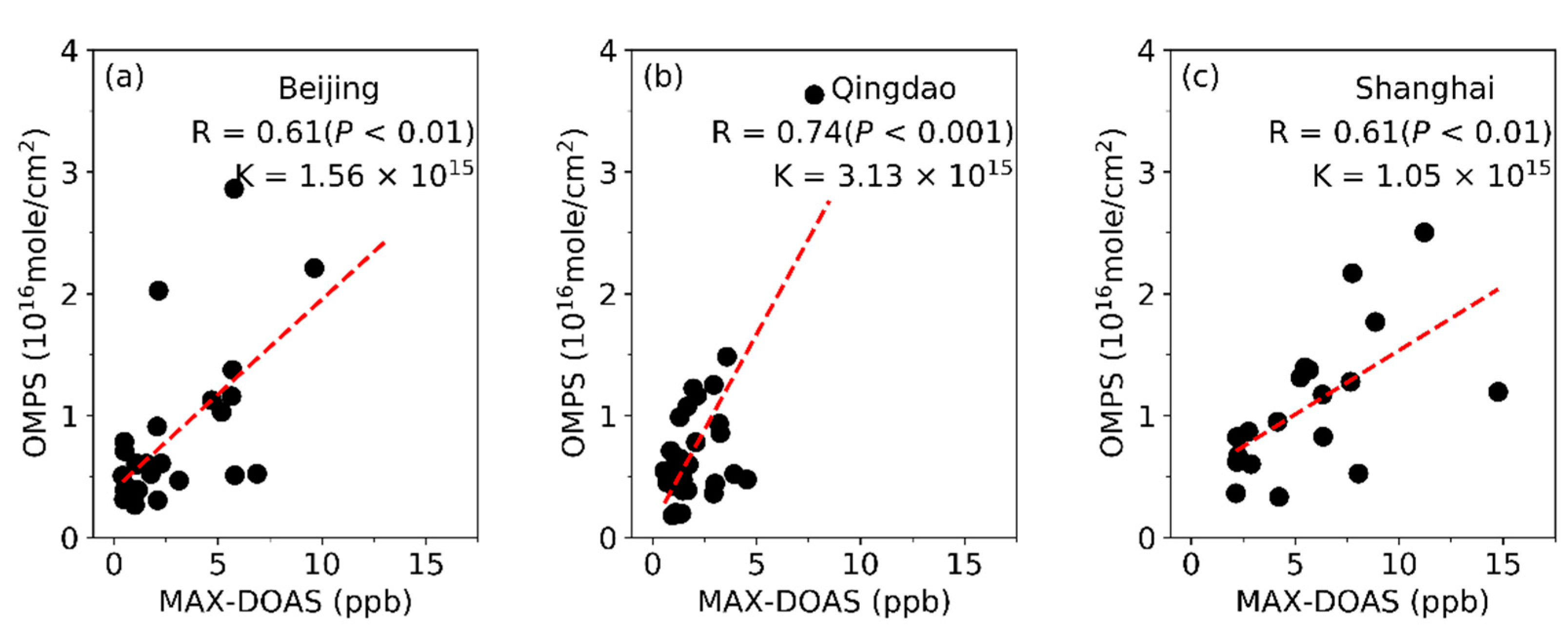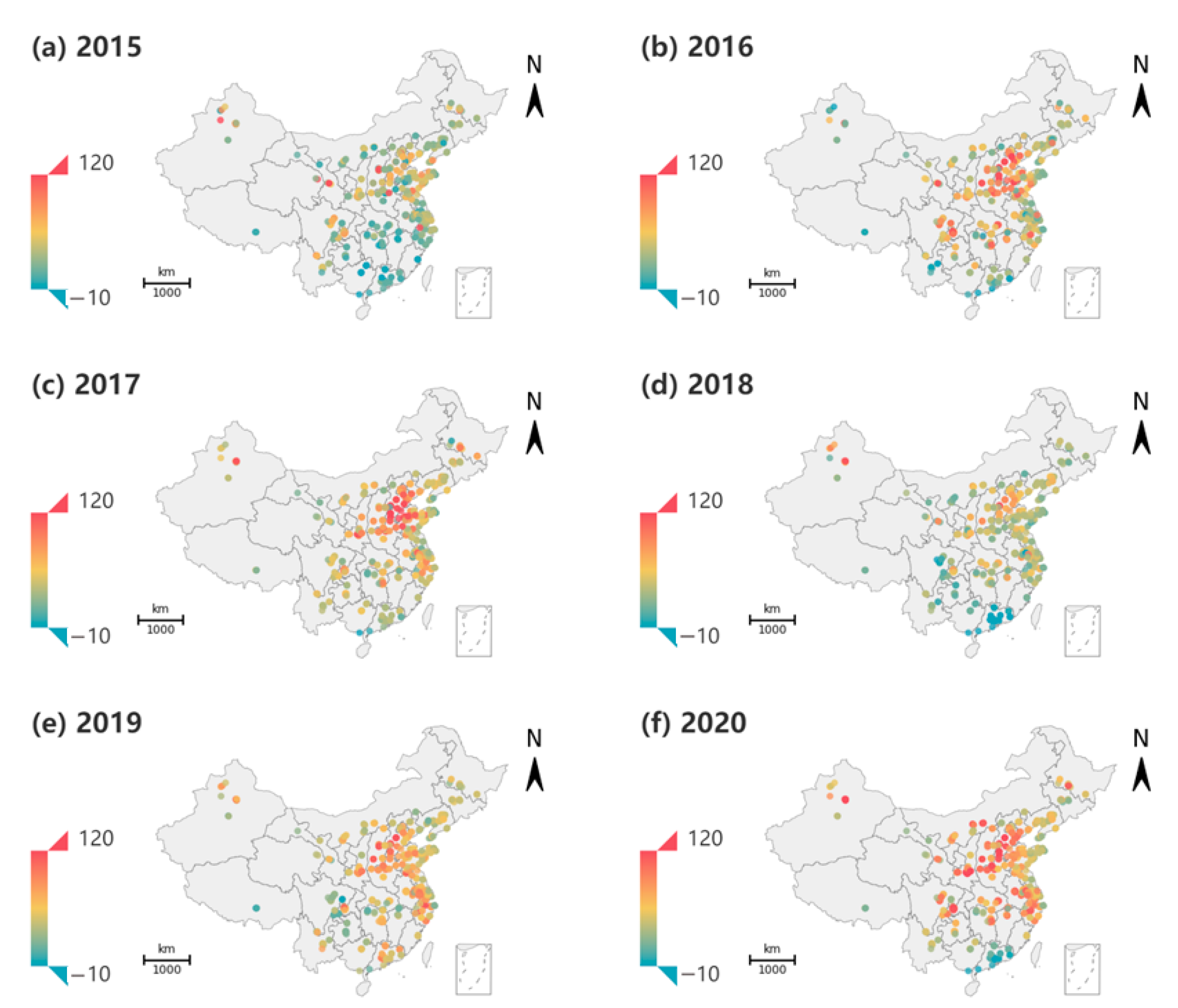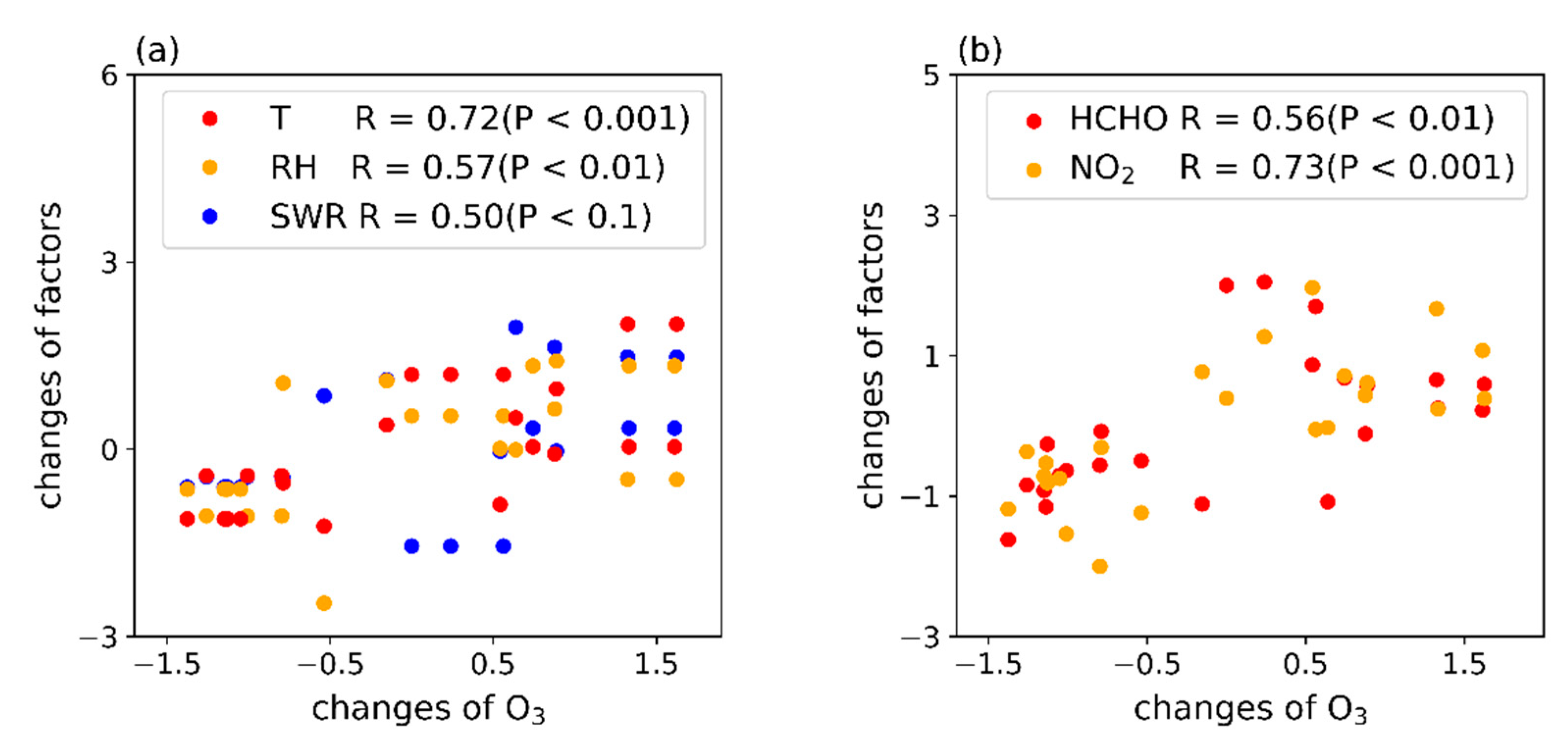Distinct Regimes of O3 Response to COVID-19 Lockdown in China
Abstract
1. Introduction
2. Materials and Methods
2.1. Meteorological Data and Observations of Air Pollutants
2.2. Statistical Analysis
3. Results
3.1. Evolution of O3 from Pre-Lockdown to Lockdown Periods over 2015–2020
3.2. Potential Driving Factors for Different Responses of O3 to Pandemic Lockdown in China
4. Discussion
Supplementary Materials
Author Contributions
Funding
Institutional Review Board Statement
Informed Consent Statement
Data Availability Statement
Acknowledgments
Conflicts of Interest
References
- Wang, P.; Chen, Y.; Hu, J.; Zhang, H.; Ying, Q. Attribution of Tropospheric Ozone to NOx and VOC Emissions: Considering Ozone Formation in the Transition Regime. Environ. Sci. Technol. 2018, 53, 1404–1412. [Google Scholar] [CrossRef] [PubMed]
- Gong, X.; Hong, S.; Jaffe, D.A. Ozone in China: Spatial Distribution and Leading Meteorological Factors Controlling O3 in 16 Chinese Cities. Aerosol Air Qual. Res. 2017, 18, 2287–2300. [Google Scholar] [CrossRef]
- Li, Y.; Lau, A.K.H.; Fung, J.C.H.; Zheng, J.; Liu, S. Importance of NOx control for peak ozone reduction in the Pearl River Delta region. J. Geophys. Res. Atmos. 2013, 118, 9428–9443. [Google Scholar] [CrossRef]
- Liu, Y.; Wang, T. Worsening urban ozone pollution in China from 2013 to 2017–Part 2: The effects of emission changes and implications for multi-pollutant control. Atmos. Chem. Phys. Discuss. 2020, 20, 6323–6337. [Google Scholar] [CrossRef]
- Guo, H.; Lyu, X.; Cheng, H.; Ling, Z.; Guo, H. Overview on the spatial–Temporal characteristics of the ozone formation regime in China. Environ. Sci. Process. Impacts 2019, 21, 916–929. [Google Scholar] [CrossRef]
- Zhang, Z.; Zhang, X.; Gong, D.; Quan, W.; Zhao, X.; Ma, Z.; Kim, S.-J. Evolution of surface O3 and PM2.5 concentrations and their relationships with meteorological conditions over the last decade in Beijing. Atmos. Environ. 2015, 108, 67–75. [Google Scholar] [CrossRef]
- World Health Organization Coronavirus Disease (COVID-19) Out-Break. Available online: https://www.who.int/emergencies/diseases/novel-coronavirus-2019 (accessed on 28 January 2021).
- Huang, X.; Ding, A.J.; Gao, J.; Zheng, B.; Zhou, D.; Qi, X.; Tang, R.; Wang, J.; Ren, C.; Nie, W.; et al. Enhanced secondary pollution offset reduction of primary emissions during COVID-19 lockdown in China. Natl. Sci. Rev. 2020, 137. [Google Scholar] [CrossRef]
- Bauwens, M.; Compernolle, S.; Stavrakou, T.; Müllerid, J.-F.; Van Gent, J.; Eskes, H.; Levelt, P.F.; Van Der, R.; Veefkind, J.P.; Vlietinck, J.; et al. Impact of Coronavirus Outbreak on NO 2 Pollution Assessed Using TROPOMI and OMI Observations. Geophys. Res. Lett. 2020, 47, 3. [Google Scholar] [CrossRef]
- Shi, X.; Brasseur, G.P. The Response in Air Quality to the Reduction of Chinese Economic Activities during the COVID-19 Outbreak. Geophys. Res. Lett. 2020, 47, 1. [Google Scholar] [CrossRef]
- Wang, Y.; Wen, Y.; Wang, Y.; Zhang, S.; Zhang, K.M.; Zheng, H.; Xing, J.; Wu, Y.; Hao, J. Four-Month Changes in Air Quality during and after the COVID-19 Lockdown in Six Megacities in China. Environ. Sci. Technol. Lett. 2020, 7, 802–808. [Google Scholar] [CrossRef]
- Zhao, Y.; Zhang, K.; Xu, X.; Shen, H.; Zhu, X.; Zhang, Y.; Hu, Y.; Shen, G. Substantial Changes in Nitrogen Dioxide and Ozone after Excluding Meteorological Impacts during the COVID-19 Outbreak in Mainland China. Environ. Sci. Technol. Lett. 2020, 7, 402–408. [Google Scholar] [CrossRef]
- Liu, T.; Wang, X.; Hu, J.; Wang, Q.; An, J.; Gong, K.; Sun, J.; Li, L.; Qin, M.; Li, J.; et al. Driving Forces of Changes in Air Quality during the COVID-19 Lockdown Period in the Yangtze River Delta Region, China. Environ. Sci. Technol. Lett. 2020, 7. [Google Scholar] [CrossRef]
- Le, T.; Wang, Y.; Liu, L.; Yang, J.; Yung, Y.L.; Li, G.; Seinfeld, J.H. Unexpected air pollution with marked emission reductions during the COVID-19 outbreak in China. Science 2020, 369, 702–706. [Google Scholar] [CrossRef] [PubMed]
- Zhang, Q.; Pan, Y.; He, Y.; Walters, W.W.; Ni, Q.; Liu, X.; Xu, G.; Shao, J.; Jiang, C. Substantial nitrogen oxides emission reduction from China due to COVID-19 and its impact on surface ozone and aerosol pollution. Sci. Total Environ. 2021, 753, 142238. [Google Scholar] [CrossRef] [PubMed]
- Chen, S.; Brune, W.H. Global sensitivity analysis of ozone production and O3–NOx–VOC limitation based on field data. Atmos. Environ. 2012, 55, 288–296. [Google Scholar] [CrossRef]
- Hersbach, H.; Dee, D. ERA5 Reanalysis Is in Production. ECMWF Newsl. 2016, 147, 5–6. [Google Scholar]
- Gao, M.; Gao, J.; Zhu, B.; Kumar, R.; Lu, X.; Song, S.; Zhang, Y.; Jia, B.; Wang, P.; Beig, G.; et al. Ozone Pollution over China and India: Seasonality and Sources. Atmos. Chem. Phys. 2020, 20, 4399–4414. [Google Scholar] [CrossRef]
- Su, W.; Liu, C.; Hu, Q.; Zhao, S.; Sun, Y.; Wang, W.; Zhu, Y.; Liu, J.; Kim, J. Primary and secondary sources of ambient formaldehyde in the Yangtze River Delta based on Ozone Mapping and Profiler Suite (OMPS) observations. Atmos. Chem. Phys. Discuss. 2019, 19, 6717–6736. [Google Scholar] [CrossRef]
- Xing, C.; Liu, C.; Wang, S.; Chan, K.L.; Gao, Y.; Huang, X.; Su, W.; Zhang, C.; Dong, Y.; Fan, G.; et al. Observations of the vertical distributions of summertime atmospheric pollutants and the corresponding ozone production in Shanghai, China. Atmos. Chem. Phys. Discuss. 2017, 17, 14275–14289. [Google Scholar] [CrossRef]
- Hönninger, G.; Von Friedeburg, C.; Platt, U. Multi axis differential optical absorption spectroscopy (MAX-DOAS). Atmos. Chem. Phys. Discuss. 2004, 4, 231–254. [Google Scholar] [CrossRef]
- Zhang, C.; Liu, C.; Hu, Q.; Cai, Z.; Su, W.; Xia, C.; Zhu, Y.; Wang, S.; Liu, J. Satellite UV-Vis Spectroscopy: Implications for Air Quality Trends and Their Driving Forces in China during 2005–2017. Light Sci. Appl. 2019, 8. [Google Scholar] [CrossRef] [PubMed]
- Su, W.; Liu, C.; Chan, K.L.; Hu, Q.; Liu, H.; Ji, X.; Zhu, Y.; Liu, T.; Zhang, C.; Chen, Y.; et al. An improved TROPOMI tropospheric HCHO retrieval over China. Atmos. Meas. Tech. 2020, 13, 6271–6292. [Google Scholar] [CrossRef]
- Zhang, C.; Liu, C.; Chan, K.L.; Hu, Q.; Liu, H.; Li, B.; Xing, C.; Tan, W.; Zhou, H.; Si, F.; et al. First Observation of Tropospheric Nitrogen Dioxide from the Environmental Trace Gases Monitoring Instrument Onboard the GaoFen-5 Satellite. Light Sci. Appl. 2020. [Google Scholar] [CrossRef] [PubMed]
- Fu, T.-M.; Jacob, D.J.; Palmer, P.I.; Chance, K.; Wang, Y.X.; Barletta, B.; Blake, D.R.; Stanton, J.C.; Pilling, M.J. Space–Based formaldehyde measurements as constraints on volatile organic compound emissions in east and south Asia and implications for ozone. J. Geophys. Res. Space Phys. 2007, 112, 1–15. [Google Scholar] [CrossRef]
- Tibshirani, R. Regression Shrinkage and Selection Via the Lasso. J. R. Stat. Soc. Ser. B Methodol. 1996, 58, 267–288. [Google Scholar] [CrossRef]
- Fike, N.; Kehoe, B.; Miller, G. Supporting software nearing the end of its life–Cycle. IEEE Global Telecommun. Conf. Exhib. Commun. Inf. Age 2003, 32, 407–499. [Google Scholar] [CrossRef]
- Wang, P.; Chen, K.; Zhu, S.; Wang, P.; Zhang, H. Severe air pollution events not avoided by reduced anthropogenic activities during COVID-19 outbreak. Resour. Conserv. Recycl. 2020, 158, 104814. [Google Scholar] [CrossRef]
- Wang, C.; Huang, X.-F.; Zhu, Q.; Cao, L.-M.; Zhang, B.; He, L.-Y. Differentiating local and regional sources of Chinese urban air pollution based on the effect of the Spring Festival. Atmos. Chem. Phys. Discuss. 2017, 17, 9103–9114. [Google Scholar] [CrossRef]
- Huang, K.; Zhuang, G.; Lin, Y.; Wang, Q.; Fu, J.S.; Zhang, R.; Li, J.; Deng, C.; Fu, Q. Impact of anthropogenic emission on air quality over a megacity–Revealed from an intensive atmospheric campaign during the Chinese Spring Festival. Atmos. Chem. Phys. Discuss. 2012, 12, 11631–11645. [Google Scholar] [CrossRef]
- Lu, X.; Zhang, L.; Chen, Y.; Zhou, M.; Zheng, B.; Li, K.; Liu, Y.; Lin, J.; Fu, T.-M.; Zhang, Q. Exploring 2016–2017 surface ozone pollution over China: Source contributions and meteorological influences. Atmos. Chem. Phys. Discuss. 2019, 19, 8339–8361. [Google Scholar] [CrossRef]
- Li, K.; Jacob, D.J.; Liao, H.; Zhu, J.; Shah, V.; Shen, L.; Bates, K.H.; Zhang, Q.; Zhai, S. A two-pollutant strategy for improving ozone and particulate air quality in China. Nat. Geosci. 2019, 12, 906–910. [Google Scholar] [CrossRef]
- Hu, B.; Liu, T.; Yang, Y.; Hong, Y.; Li, M.; Xu, L.; Wang, H.; Chen, N.; Wu, X.; Chen, J. Characteristics and Formation Mechanism of Surface Ozone in a Coastal Island of Southeast China: Influence of Sea-land Breezes and Regional Transport. Aerosol Air Qual. Res. 2019, 19, 1734–1748. [Google Scholar] [CrossRef]
- Wang, J.; Yang, Y.; Zhang, Y.; Niu, T.; Jiang, X.; Wang, Y.; Che, H. Influence of meteorological conditions on explosive increase in O3 concentration in troposphere. Sci. Total Environ. 2019, 652, 1228–1241. [Google Scholar] [CrossRef] [PubMed]
- Wang, T.; Xue, L.; Brimblecombe, P.; Lam, Y.F.; Likun, X.; Zhang, L. Ozone pollution in China: A review of concentrations, meteorological influences, chemical precursors, and effects. Sci. Total Environ. 2017, 575, 1582–1596. [Google Scholar] [CrossRef]
- Zhao, S.; Yin, D.; Yu, Y.; Kang, S.; Qin, D.; Dong, L. PM2.5 and O3 pollution during 2015–2019 over 367 Chinese cities: Spatiotemporal variations, meteorological and topographical impacts. Environ. Pollut. 2020, 264, 114694. [Google Scholar] [CrossRef]
- Chu, B.; Ma, Q.; Liu, J.; Ma, J.; Zhang, P.; Chen, T.; Feng, Q.; Wang, C.; Yang, N.; Ma, H.; et al. Air Pollutant Correlations in China: Secondary Air Pollutant Responses to NOx and SO2 Control. Environ. Sci. Technol. Lett. 2020, 7, 695–700. [Google Scholar] [CrossRef]
- Wang, P.; Guo, H.; Hu, J.; Kota, S.H.; Ying, Q.; Zhang, H. Responses of PM2.5 and O3 concentrations to changes of meteorology and emissions in China. Sci. Total Environ. 2019, 662, 297–306. [Google Scholar] [CrossRef]
- Reynolds, S.D.; Blanchard, C.L.; Ziman, S.D. Understanding the effectiveness of precursor reductions in lowering 8 hr ozone concentrations. J. Air Waste Manag. Assoc. 2003, 53, 195–205. [Google Scholar] [CrossRef][Green Version]
- Jin, X.; Fiore, A.M.; Murray, L.T.; Valin, L.C.; Lamsal, L.N.; Duncan, B.; Boersma, K.F.; De Smedt, I.; Abad, G.G.; Chance, K.; et al. Evaluating a Space-Based Indicator of Surface Ozone-NOx-VOC Sensitivity Over Midlatitude Source Regions and Application to Decadal Trends. J. Geophys. Res. Atmos. 2017, 122, 10–439. [Google Scholar] [CrossRef]
- Gao, M.; Saide, P.E.; Xin, J.; Wang, Y.; Liu, Z.; Wang, Y.; Wang, Z.; Pagowski, M.; Guttikunda, S.K.; Carmichael, G.R. Estimates of Health Impacts and Radiative Forcing in Winter Haze in Eastern China through Constraints of Surface PM2.5 Predictions. Environ. Sci. Technol. 2017, 51, 2178–2185. [Google Scholar] [CrossRef]





| China | 2015 | 2016 | 2017 | 2018 | 2019 | 2015–2019 | 2020 |
|---|---|---|---|---|---|---|---|
| pre-lockdown | 23.28 | 22.56 | 25.54 | 27.59 | 21.69 | 24.13 | 23.93 |
| lockdown | 29.31 | 33.07 | 39.14 | 36.42 | 32.96 | 34.18 | 39.31 |
| percentage | 25.90 | 46.59 | 53.25 | 32.00 | 51.96 | 41.63 | 64.27 |
| significance | *** | *** | *** | *** | *** | *** | - |
| BTH | |||||||
| pre-lockdown | 17.82 | 16.21 | 17.69 | 22.48 | 18.92 | 18.62 | 19.30 |
| lockdown | 25.84 | 30.34 | 33.53 | 35.88 | 31.75 | 31.47 | 36.71 |
| percentage | 45.01 | 87.17 | 89.54 | 59.61 | 67.81 | 69.99 | 90.21 |
| significance | *** | - | - | *** | *** | *** | - |
| YRD | |||||||
| pre-lockdown | 25.24 | 26.36 | 28.07 | 27.07 | 21.42 | 25.63 | 24.03 |
| lockdown | 32.23 | 37.06 | 42.74 | 36.99 | 35.05 | 36.81 | 41.28 |
| percentage | 27.69 | 40.59 | 52.26 | 36.65 | 63.63 | 43.62 | 71.79 |
| significance | *** | *** | *** | *** | * | *** | - |
| PRD | |||||||
| pre-lockdown | 38.45 | 23.92 | 37.78 | 44.75 | 23.25 | 33.63 | 39.09 |
| lockdown | 40.72 | 27.71 | 49.79 | 38.07 | 36.80 | 38.62 | 38.66 |
| percentage | 5.90 | 15.84 | 31.79 | −14.93 | 58.28 | 14.83 | −1.10 |
| significance | * | *** | *** | *** | *** | *** | - |
Publisher’s Note: MDPI stays neutral with regard to jurisdictional claims in published maps and institutional affiliations. |
© 2021 by the authors. Licensee MDPI, Basel, Switzerland. This article is an open access article distributed under the terms and conditions of the Creative Commons Attribution (CC BY) license (http://creativecommons.org/licenses/by/4.0/).
Share and Cite
Liu, S.; Liu, C.; Hu, Q.; Su, W.; Yang, X.; Lin, J.; Zhang, C.; Xing, C.; Ji, X.; Tan, W.; et al. Distinct Regimes of O3 Response to COVID-19 Lockdown in China. Atmosphere 2021, 12, 184. https://doi.org/10.3390/atmos12020184
Liu S, Liu C, Hu Q, Su W, Yang X, Lin J, Zhang C, Xing C, Ji X, Tan W, et al. Distinct Regimes of O3 Response to COVID-19 Lockdown in China. Atmosphere. 2021; 12(2):184. https://doi.org/10.3390/atmos12020184
Chicago/Turabian StyleLiu, Shanshan, Cheng Liu, Qihou Hu, Wenjing Su, Xian Yang, Jinan Lin, Chengxin Zhang, Chengzhi Xing, Xiangguang Ji, Wei Tan, and et al. 2021. "Distinct Regimes of O3 Response to COVID-19 Lockdown in China" Atmosphere 12, no. 2: 184. https://doi.org/10.3390/atmos12020184
APA StyleLiu, S., Liu, C., Hu, Q., Su, W., Yang, X., Lin, J., Zhang, C., Xing, C., Ji, X., Tan, W., Liu, H., & Gao, M. (2021). Distinct Regimes of O3 Response to COVID-19 Lockdown in China. Atmosphere, 12(2), 184. https://doi.org/10.3390/atmos12020184













